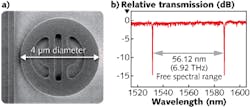In addition to the requirement for high-speed operation and low power consumption, components for next-generation integrated, silicon-photonics-based telecommunications and computing architectures must be compact. Microdisk modulators as small as 3.5 μm in diameter have been fabricated using a depletion-based vertical p-n junction and interior electrical contacts that operate at 12.5 Gbit/s with a 3.2 dB extinction rate at 1 V drive voltage and 3 fJ/bit power consumption, but higher-order spatial modes corrupt free spectral range (FSR). This limits values to around 4 THz and consequently limits communications bandwidth. Scientists at the Massachusetts Institute of Technology (MIT; Cambridge, MA) and Sandia National Laboratories (Albuquerque, NM) have developed an “adiabatic” silicon microring modulator that maintains high speed with low power consumption at a 4 μm diameter with a 6.9 THz FSR.
In thermodynamics, the term adiabatic refers to any process without gain or loss of heat. But in guided-wave optics, adiabatic describes a structure that does not induce radiation, or otherwise enables lossless evolutions in the structure geometry. The adiabatic microring modulator design uses a narrower width in the singlemode coupling region of the ring that supports only fundamental singlemode operation without requiring a ridge waveguide. The design reduces diameter by more than 2X, doubles the FSR, and occupies 1/10 the area of comparable modulators as electrical contacts are contained entirely within the interior of the microring. Contact Michael Watts at [email protected].

